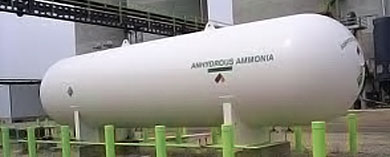
- (03) 5909 8218
- enquiry@fusionweld.com.au
Anhydrous Ammonia Storage
June 23, 2014

The health risks associated with anhydrous ammonia are well documented. They range from caustic effects capable of burning the respiratory system to environmental fallout on a highly toxic scale. And, thanks to a clear gaseous composition, the substance can spread far-and-wide, only detected when a concentrate reaches the odor threshold. Stored as one of industries most commonly employed chemicals, a key component of fertilizers, the compound is typically held cooled in its liquid form.
Communities go about their daily lives close to a storage facility containing anhydrous ammonia vessels. Thousands of facilities store substantial amounts of the compound, with many of these facilities located close to farming areas where fertilizers are used to grow bumper crops. These storage areas obviously institute regulated risk management plans, but the impetus lays upon engineering reliable vessels to safely store the substance. The vessels are designed from materials with a chemical certitude that guarantees no reaction with the caustic compound. That means no copper or zinc can be used in the construction of the tank or the fittings. Brass, a mix of copper and zinc, can find no place in the project. Brass and copper are soft metals, and it's unlikely they'd be employed in the construction of a large process vessel in any eventuality, but there's always the possibility of brass being used in fixtures, on gauge pipes and as seating, a scenario that must be avoided.
Using precision-fabricated steel and iron in the manufacturing process is the recommended approach. This construction also accounts for the pressurization constraints of the hazardous substance, since anhydrous ammonia is typically stored under pressure to increase the volume of the substance before it's used to manufacture a fertilizer product. This is simple physics and chemistry in action. Let's illustrate the point by stating that a single cubic foot of the compound in its liquid state equals 855 cubic feet of ammonia gas. The rated pressure vessel must then withstand an internal pressure of at least 250 pounds per square inch, although this figure may differ slightly depending on the regulatory authority or country where the vessel is bound for use. The total capacity of the tank must account for pressure factors and for the chemical characteristics of the substance. For example, there's an expansion factor to consider, a function of chemical inflation that classifies 85% of the vessel as having a usable capacity while the remaining 15% is defined as vapor space. Also, note that the compound has an affinity for water, and make provisions to keep the tank platform dry.
A number of safety factors and relevant codes shape the design of the tank, most of which we've already covered. Refer to data sheets for further details on safety procedures, on the chemical properties of the compound and the hazards to organic tissue. The vessel must also be installed at a recommended distance from traffic and built on a suitable foundation. Finally, all gauges must be free of copper, zinc and alloys employing the two elements.
Contact Details
Fusion - Weld Engineering Pty Ltd
ABN 98 068 987619
1865 Frankston Flinders Road,
Hastings, VIC 3915
Ph: (03) 5909 8218
Optimized by NetwizardSEO.com.au
Recent Posts
- Mitigating Hydrogen-Induced Cracking in Pressure Vessels: Engineering and Material Strategies
- Storage Tank Solutions Australia: Field-Erected, Prefabricated & Self-Bunded Explained
- Reducing Environmental Risks: Self-Bunded Tanks in Australian Oil & Gas Operations
- Precision in Production: How Pressure Vessels Are Manufactured for Industrial Safety
- Shell & Tube Heat Exchangers: Improve Thermal Control & Energy Recovery in Petrochemical & Pharmaceutical Plants
- In-Service Inspection for Compressed Air Receivers for Power Plant Shutdown Prevention
- Power Plant Pipe Spooling Fabrication – Get Rapid, Code-Compliant Spools Ready for Installation
- Field Erected Tanks: Safe, Reliable On-Site Fuel Storage Solutions in Australia
- Custom Pressure Vessel Fabrication for Flammable Gases
- Heat Exchangers for Oil & Gas Refineries - Custom-Built for Performance & Compliance
Posts 2025
- Mitigating Hydrogen-Induced Cracking in Pressure Vessels: Engineering and Material Strategies
- Storage Tank Solutions Australia: Field-Erected, Prefabricated & Self-Bunded Explained
- View all articles…
Posts 2024
- Large Process Vessels: Optimising the Design for Maximum Efficiency [2025]
- Pressure Equipment Management System Installation: Detect Equipment Faults Early
- View all articles…
Posts 2023
- Pressure Piping System Inspection: A Gift of Safety for the Holidays
- Deaerator Inspections by Fusion-Weld Engineering and How They Reduce System Downtime
- View all articles…
Posts 2022
- How Fusion Weld Keeps Up With AS-NZS ISO 9001:2008 Standard
- Boiler Equipment Safety Inspection During the Summer Season
- View all articles…
Posts 2021
- Avoid These Factors and Practices that Contribute to Sealing Damage in Pressure Vessels
- Do's And Don'ts Of Industrial Boiler Inspection And Maintenance From Fusion-Weld
- View all articles…
Posts 2020
- What are the Risks and Hazards Involved in Pressure Vessel Equipment?
- How to Know if Your Pressure Equipment Needs Repair or Replacement?
- View all articles…
Posts 2019
- Factors that Contribute to Pressure Vessel Failure
- Pressure Vessel Regulations in Australia: What are the Mandatory Requirements?
- View all articles…
Posts 2018
- Pros and Cons of Spherical vs. Cylindrical Pressure Vessels
- What are the Different Hazard Levels in Pressure Vessels?
- View all articles…
Posts 2017
- Transportable Pressure Vessels: The Importance of Inspection and Safety Checks
- Fracture Mechanics and Stress Analysis of Cracks in Pressure Vessels
- View all articles…
Posts 2016
Posts 2015
- What Are Deaerators & Feedwater Vessels?
- Precautions and Safety for Compressed Air Receiver Vessels
- View all articles…
Posts 2014
- Demonstrating In-process Inspection Procedures
- Static Grounding Practices and Standards
- View all articles…